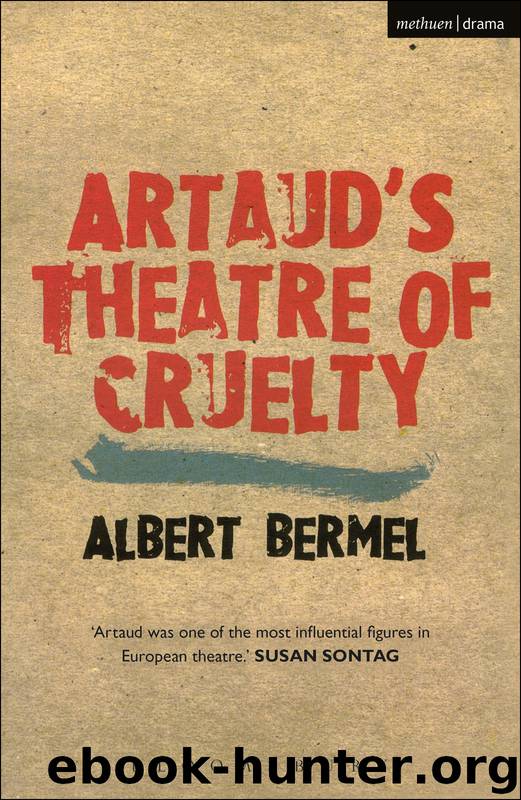Artaud's Theatre Of Cruelty by Bermel Albert;

Author:Bermel, Albert;
Language: eng
Format: epub
Publisher: Bloomsbury Publishing
Published: 2001-02-20T16:00:00+00:00
CHAPTER 7: PLAYWRIGHT
1. Craig was not a playwright, as were Zeami, Molière and Artaud, in that he did not compose dialogue. But he believed in imposing his own stage directions on play texts, and even considered the playwright who wrote in such directions to be a trespasser on the stage director’s territory.
2. Craig’s ideal theatre, envisaged from his essays, letters, drawings, and the magazine he edited, The Mask, appears a great deal cooler and more restrained than Artaud’s does. If Craig is a mountain, Artaud is a volcano. Further, Craig’s autocratic temperament made him less of a working partner for the actors and designer and technical staff than Artaud was.
3. Collected Works, Vol. 2, p. 33, and p. 217, note 18.
4. Artaud also left a number of film scenarios; one finished film, The Shell and the Clergyman, was based on his screenplay. A radio play called To Put an End to God’s Judgment was recorded but not broadcast in Artaud’s lifetime. These non-theatrical writings will not be discussed here.
5. The two versions are translated in the Collected Works, Vol. 1, pp. 51–54 and 147–151. The first volume of the French revised and corrected edition includes a footnote that refers to an untraced third draft.
6. Bettina Knapp, Antonin Artaud: Man of Vision, p. 30.
7. Some translations have it that the scorpions swarm over the Wetnurse’s sex, rather than the Knight’s (the French words son sexe being ambiguous). But the swelling, bursting and the sun image seem to me more plausibly a reference to the male organ of the Knight. In addition, the scene suggests not only that the Wetnurse is ‘infected’ with scorpions but also that she transmits the infection to the male species.
8. The discussion here of The Fountain of Blood is a summary of the lengthier and more detailed study included in Contradictory Characters by Albert Bermel (Second Edition, 1996, Evanston, Il.), pp. 256–268.
9. Bettina Knapp (Antonin Artaud: Man of Vision) takes it very seriously indeed, seeing in it the story of Artaud’s ‘enormous struggle and preoccupation with his health’ and ‘new light shed on Artaud’s inner development’, loads of ‘symbolism of the most basic kind’ analagous to Wagner’s four operas of The Ring of the Niebelung; a quest by the author for his identity; Isabelle as a representation of ‘too much sexuality’ and Dr Pale as ‘too much intellectuality’ – Artaud suddenly becomes a salesman for the golden mean – and a spirituality (the bouncing up and down of Harlequin and Isabelle) that ‘implies a total negation of the physical world’. To Ms Knapp’s credit she does attempt to say something about this and other plays, whereas some critics glance off each of the plays with an evasive sentence or two.
10. Two versions of the play, in handwriting and typescript respectively, have a number of differences in the detail, mostly the result of editing, but the changes do not substantially alter the play’s meanings or form.
11. In some notes written on the back of the manuscript copy, Artaud
Download
This site does not store any files on its server. We only index and link to content provided by other sites. Please contact the content providers to delete copyright contents if any and email us, we'll remove relevant links or contents immediately.
| African | Asian |
| Australian & Oceanian | Canadian |
| Caribbean & Latin American | European |
| Jewish | Middle Eastern |
| Russian | United States |
4 3 2 1: A Novel by Paul Auster(11776)
The handmaid's tale by Margaret Atwood(7437)
Giovanni's Room by James Baldwin(6799)
Asking the Right Questions: A Guide to Critical Thinking by M. Neil Browne & Stuart M. Keeley(5351)
Big Magic: Creative Living Beyond Fear by Elizabeth Gilbert(5344)
Ego Is the Enemy by Ryan Holiday(4942)
On Writing A Memoir of the Craft by Stephen King(4657)
The Body: A Guide for Occupants by Bill Bryson(4576)
Ken Follett - World without end by Ken Follett(4439)
Bluets by Maggie Nelson(4256)
Adulting by Kelly Williams Brown(4229)
Eat That Frog! by Brian Tracy(4147)
Guilty Pleasures by Laurell K Hamilton(4112)
White Noise - A Novel by Don DeLillo(3825)
The Poetry of Pablo Neruda by Pablo Neruda(3811)
Fingerprints of the Gods by Graham Hancock(3731)
Alive: The Story of the Andes Survivors by Piers Paul Read(3724)
The Book of Joy by Dalai Lama(3686)
The Bookshop by Penelope Fitzgerald(3615)
